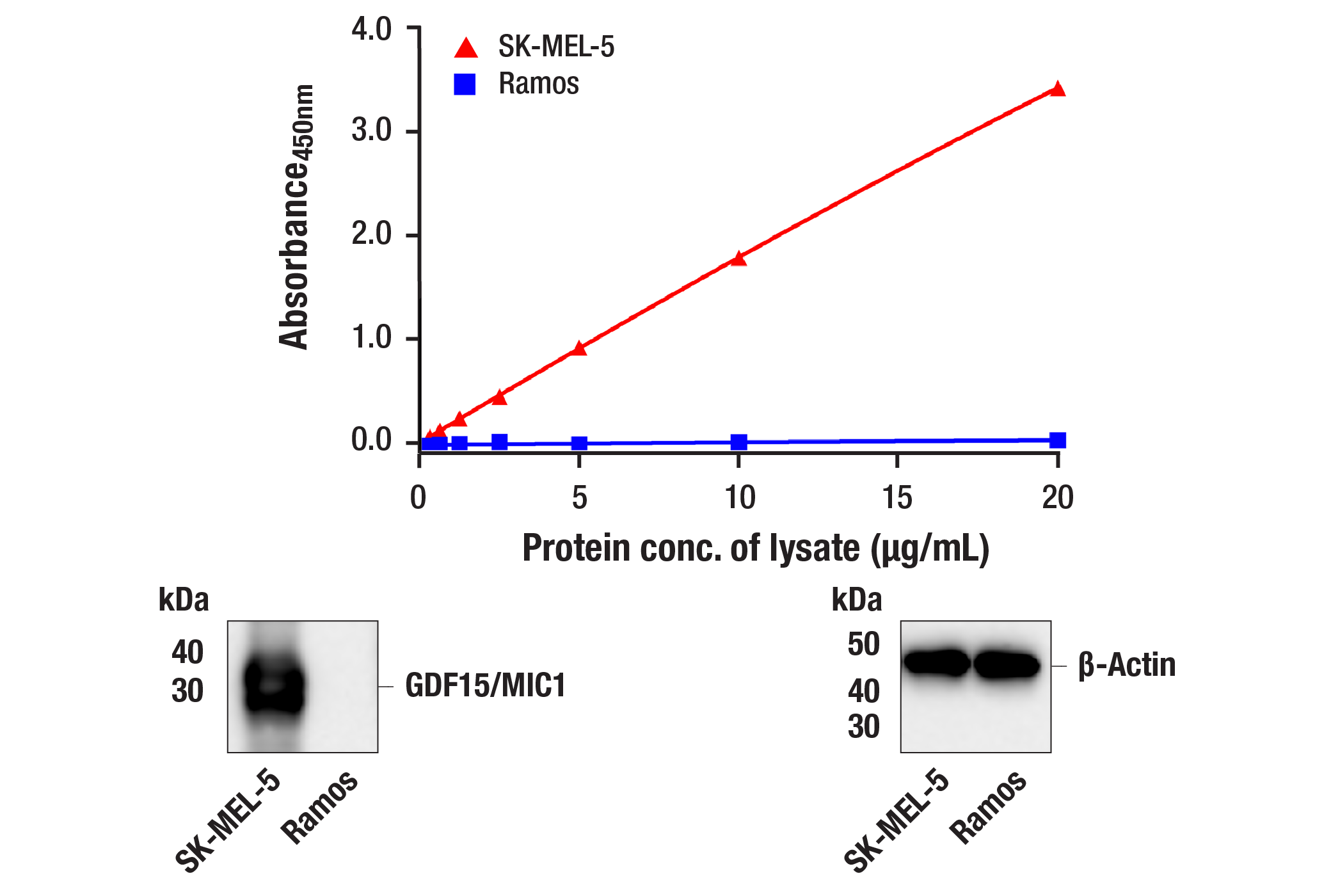| Product Includes | Product # | Quantity | Color | Storage Temp |
|---|---|---|---|---|
| GDF15/MIC1 Rabbit mAb Coated Microwells | 90822 | 96 tests |
|
+4C |
| GDF15/MIC1 Rabbit Detection mAb | 98486 | 1 ea |
|
+4C |
| HRP Diluent | 13515 | 5.5 ml |
|
+4C |
| TMB Substrate | 7004 | 11 ml |
|
+4C |
| STOP Solution | 7002 | 11 ml |
|
+4C |
| Sealing Tape | 54503 | 2 ea |
|
+4C |
| ELISA Wash Buffer (20X) | 9801 | 25 ml |
|
+4C |
| Cell Lysis Buffer (10X) | 9803 | 15 ml |
|
-20C |
*The microwell plate is supplied as 12 8-well modules - Each module is designed to break apart for 8 tests.
Description
The rapid protocol (RP) PathScan® RP GDF15/MIC1 Sandwich ELISA Kit is a solid phase sandwich enzyme-linked immunosorbent assay (ELISA) that detects endogenous levels of GDF15/MIC1 protein in a reduced assay time of 1.5 hours. Incubation of cell lysates and detection antibody on the coated microwell plate forms a sandwich with GDF15/MIC1 protein in a single step. The plate is then extensively washed and TMB reagent is added for signal development. The magnitude of absorbance for the developed color is proportional to the quantity of GDF15/MIC1 protein. Learn more about your ELISA kit options here.
*Antibodies in this kit are custom formulations specific to kit.
Specificity/Sensitivity
Background
Macrophage inhibitory cytokine-1 (Mic-1), also termed GDF15 (1), PTGF-β (2), PLAB (3), PDF (4), and NAG-1 (5), is a divergent member of the transforming growth factor-β (TGF-β) superfamily (6). Like other family members, Mic-1 is synthesized as an inactive precursor that undergoes proteolytic processing involving removal of an N-terminal hydrophobic signal sequence followed by cleavage at a conserved RXXR site, generating an active C-terminal domain that is secreted as a dimeric protein. Mic-1 is highly expressed in the placenta and is also dramatically increased by cellular stress, acute injury, inflammation, and cancer. In the brain, Mic-1 is found in the choroid plexus and is secreted into the cerebrospinal fluid (7). It is also a transcriptional target of the p53 tumor suppressor protein and may serve as a biomarker for p53 activity (8,9). During tumor progression, Mic-1 has various effects on apoptosis, differentiation, angiogenesis, and metastasis, and may also contribute to weight loss during cancer (10,11).
- Strelau, J. et al. (2000) J Neurosci 20, 8597-603.
- Yokoyama-Kobayashi, M. et al. (1997) J Biochem 122, 622-6.
- Hromas, R. et al. (1997) Biochim Biophys Acta 1354, 40-4.
- Paralkar, V.M. et al. (1998) J Biol Chem 273, 13760-7.
- Baek, S.J. et al. (2001) J Biol Chem 276, 33384-92.
- Bootcov, M.R. et al. (1997) Proc Natl Acad Sci USA 94, 11514-9.
- Strelau, J. et al. (2000) J Neural Transm Suppl, 273-6.
- Kannan, K. et al. (2000) FEBS Lett 470, 77-82.
- Yang, H. et al. (2003) Mol Cancer Ther 2, 1023-9.
- Johnen, H. et al. (2007) Nat Med 13, 1333-40.
- Bauskin, A.R. et al. (2006) Cancer Res 66, 4983-6.
Background References
Cross-Reactivity Key
H: human M: mouse R: rat Hm: hamster Mk: monkey Vir: virus Mi: mink C: chicken Dm: D. melanogaster X: Xenopus Z: zebrafish B: bovine Dg: dog Pg: pig Sc: S. cerevisiae Ce: C. elegans Hr: horse GP: Guinea Pig Rab: rabbit All: all species expected
Trademarks and Patents
使用に関する制限
法的な権限を与えられたCSTの担当者が署名した書面によって別途明示的に合意された場合を除き、 CST、その関連会社または代理店が提供する製品には以下の条件が適用されます。お客様が定める条件でここに定められた条件に含まれるものを超えるもの、 または、ここに定められた条件と異なるものは、法的な権限を与えられたCSTの担当者が別途書面にて受諾した場合を除き、拒絶され、 いかなる効力も効果も有しません。
研究専用 (For Research Use Only) またはこれに類似する表示がされた製品は、 いかなる目的についても FDA または外国もしくは国内のその他の規制機関により承認、認可または許可を受けていません。 お客様は製品を診断もしくは治療目的で使用してはならず、また、製品に表示された内容に違反する方法で使用してはなりません。 CST が販売または使用許諾する製品は、エンドユーザーであるお客様に対し、使途を研究および開発のみに限定して提供されるものです。 診断、予防もしくは治療目的で製品を使用することまたは製品を再販売 (単独であるか他の製品等の一部であるかを問いません) もしくはその他の商業的利用の目的で購入することについては、CST から別途許諾を得る必要があります。 お客様は以下の事項を遵守しなければなりません。(a) CST の製品 (単独であるか他の資材と一緒であるかを問いません) を販売、使用許諾、貸与、寄付もしくはその他の態様で第三者に譲渡したり使用させたりしてはなりません。また、商用の製品を製造するために CST の製品を使用してはなりません。(b) 複製、改変、リバースエンジニアリング、逆コンパイル、 分解または他の方法により製品の構造または技術を解明しようとしてはなりません。また、 CST の製品またはサービスと競合する製品またはサービスを開発する目的で CST の製品を使用してはなりません。(c) CST の製品の商標、商号、ロゴ、特許または著作権に関する通知または表示を除去したり改変したりしてはなりません。(d) CST の製品をCST 製品販売条件(CST’s Product Terms of Sale) および該当する書面のみに従って使用しなければなりません。(e) CST の製品に関連してお客様が使用する第三者の製品またはサービスに関する使用許諾条件、 サービス提供条件またはこれに類する合意事項を遵守しなければなりません。
